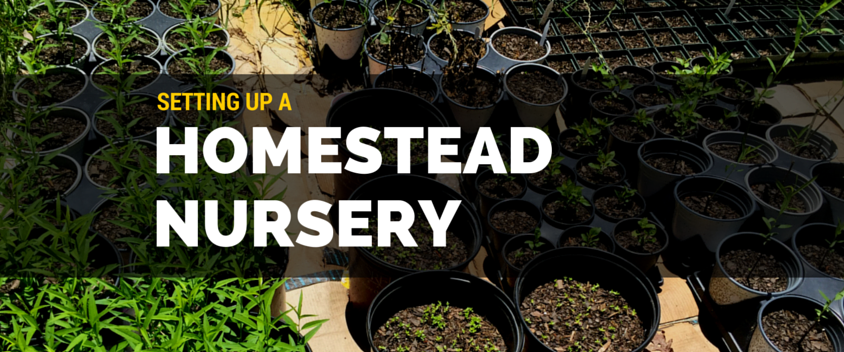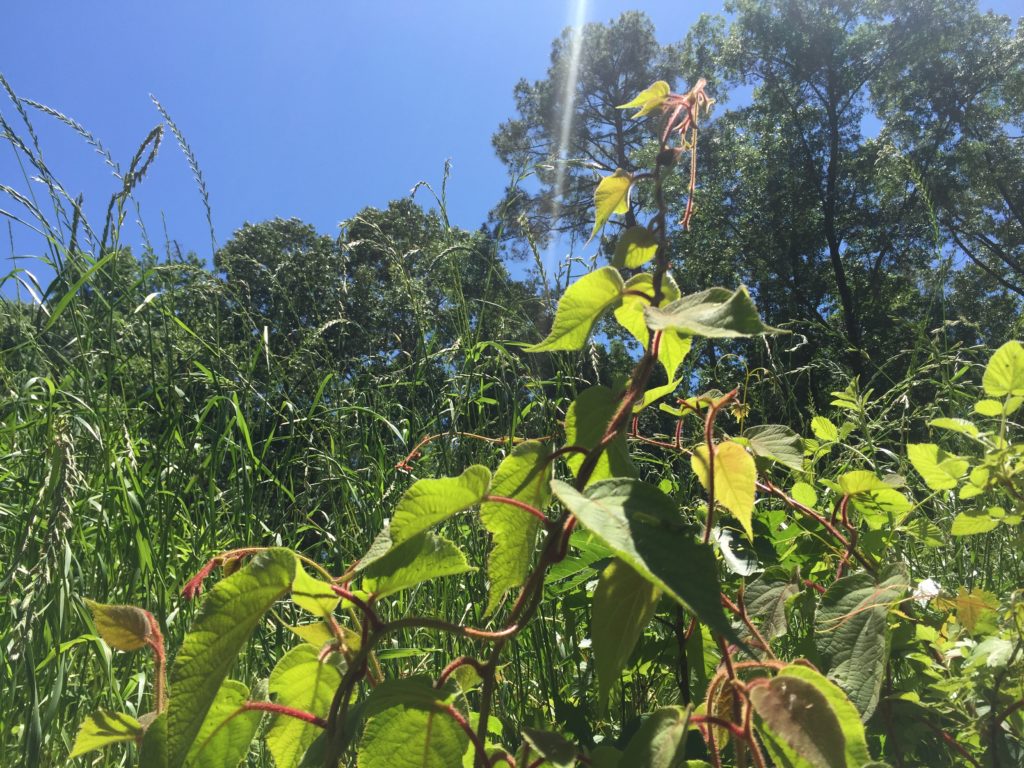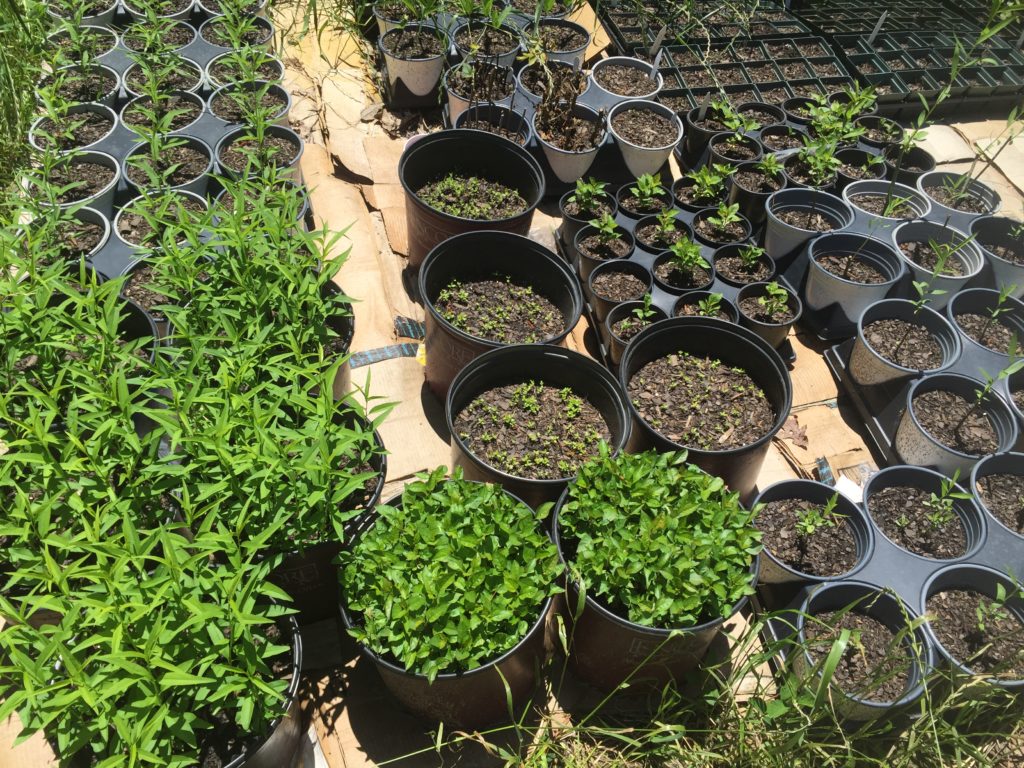E0019 | Small Scale Nursery Setup
Podcast: Play in new window | Download
Subscribe: iTunes | Android | RSS
Setting up a Homestead Nursery
We’ve got a big, big topic to cover today and tons of questions I won’t be able to answer, so this episode is going to be lightly skimming the surface of the idea of setting up a small nursery. I’ll go over some considerations, but there is no way I can actually teach you the plant propagation methods with only text or spoken word, so if you want to get all the details and how-to information, you’ll have to wait for the course I’m working on this year. But in the meantime, we can still talk about the kinds of things that I can practically cover on this subject.
News
It’s been raining. Almost every day rain. Seriously it’s kind of like we’ve been transported in time and space to the north west coast it’s been so cloudy and rainy! The garden is a riot of overgrowth and I really need to get out there and do some maintenance and mulching. So much work to do, so little time to do it! I’m about to miss my window to stick cuttings for the spring if I don’t get my mist system set back up. But you know what? I just need to take a page out of my own advice book and pick one thing, get it done, then move on to the next thing. So that’s what I’m going to have to do this weekend! Get the mist system set back up! Gotta do it!
Plant of the Week
Hardy Kiwi! Did you know that even if you live somewhere that you can’t grow the normal fuzzy kiwi, that you can grow a kiwi that’s similar? Doesn’t matter if you’re up north somewhere super cold, you can grow Hardy Kiwi! We are talking about Actinidia aruguta, that is the hardy kiwi native to Japan, Korea, Northern China, and Russian Siberia.
A couple of tips before we get into the details, you want to purchase at least one male plant for every nine female plants to ensure pollination and fruit set. Avoid planting in frost pockets, sites with northern exposure are better because they delay early growth in spring which can be damaged by a late frost.
Propagation
You can take hardwood cuttings anytime after the plant has received 500 hours of chilling, or go with softwood cuttings in late spring to early summer. You can also propagate them by layering of course. To grow plants from seed, remove the seeds from a mature fruit and let them dry for a couple days. Refrigerate them in moist perlite or vermiculite at 35-40 F for 120 days. Then surface sow in a sterile potting mix and cover the container to keep the humidity high. Like I always harp on, the soil should be moist but not wet. As soon as the plants germinate uncover the container to help reduce fungal issues. After the seedlings are up, put a thin layer of clean sand on top of the medium. When plants have four true leaves, transplant them to individual pots.
Site selection and soil
They thrive in moist soils but do not tolerate poorly drained soils. While most cultivars are hardy to Zone 4, they require about a 150-day frost free season to produce fruit reliably.
Trellising
They definitely require a trellis or other support structure. So make sure you have something for them to climb on. They are vigorous growers and will get quite heavy, especially when fruiting.
Harvest
Kiwifruit will not reach maturity and flower until about their fifth year. Fruit matures in October, which is -after the date of the first frost in many northern regions. So this makes it difficult to harvest vine-ripened fruit up north. Fruits will ripen in the refrigerator, but their storage life is much shorter than that of the commercially available kiwifruit. Flavor is better, however, in the fuzzless hardy kiwi.
Interesting Things
Chicken brooding came up on facebook recently and someone was astonished at the way I brood my chickens. Most people put their newly hatched chicks in a small box with food and water, and put a heat lamp on them to keep them warm. But that’s not what I do. One person actually got upset at me when I said what I do.
As soon as the chick dries off and fluffs up, and looks like it can walk around and move just fine. It goes out of the incubator into the outdoor brooder. There’s a heat lamp to keep them warm and a cowl that comes to about 4 inches above the ground so they can get under that for lots of warmth, or move towards the edge to cool off, or come out from under the cowl all together to get food and water. The food, water, heat lamp is all under a low roof, inside a chicken tractor on the ground outside. They learn to eat bugs quickly, they eat leaves and seeds on day 1. I have fewer losses than a brooder and this way I can move the whole thing every few days and I never have a stinky nasty poop filled brooder. Just chickens who are used to living in a chicken tractor. Pretty neat if I do say so myself.
Small Scale Nursery Setup
Let’s get into the topic of the day! And I want to start out with talking about why I’m setting up a small scale nursery on my site and you might decide something like this would benefit you as well!
Why a Nursery?
Well for me it means that I’ll be able to grow all the plants I want to use on the property myself. If I were to buy all the plants outright, there’s no way I could develop this property on the budget I have. It would cost well over a hundred thousand dollars to do what I want to do and we’re only talking about 4 or 5 acres! So when you think of it that way, it really quickly becomes clear that if you have more than an acre to plant, growing your own makes a ton of sense. I mean, just think about how expensive a single fruit tree is! Go to a nursery and price a fig tree. Twenty bucks per pot, it’s the same with most fruit trees and bushes. Do you know how easy it is to propagate a fig? You cut a branch and stick it in the ground! Now sure there are a few technical details, but for the most part, that’s all you have to do! Having your own small nursery means very cheap plants to fill in areas that are unproductive and make them yield something that you would otherwise be buying from the grocery store. Who wouldn’t want to be able to just grab a handful of little blueberry bushes that are sitting over there in the shade when you have a spare moment to plant some shrubs. Bam! Now you have 5 extra blueberry bushes that are going to be producing fruit in a couple years.
What about extra income? I’m not talking about replacing your 9-5 day job, but every little bit counts. If you can reduce your dependence on outside sources, and become a little more self-reliant, and a little bit more every year. Pretty soon you are only going to the grocery store once a month, then maybe once every couple months. Then maybe you become so self sufficient that you only go a couple times a year. How much time does that save you standing in line at wally world? I for one would much rather spend my time in my own garden picking strawberries for dessert than stand in line to buy a little package of the fruit that’s been soaked in pesticides and fracking recycled water with who knows what kinds of chemicals infusing the bright red little berries. No sir, I want to grow my own.
Components of an Effective Nursery
So if you aren’t already itching to set up your own nursery, you should be, shame on you. Let’s talk about some of the components of an effective nursery and get that information stewing.
Irrigation
You are going to need water. Plants absolutely need it, and a lot of times when propagating plants, you need more than usual because they’re so tender and fragile. So having some good clean water available with decent pressure is a total must. What kind of water? Most people probably wouldn’t even ask that question. You can use most any water, but there are degrees of benefits you will find, as well as degrees of difficulty when you have certain types of water chemistry. If you’re on city water, it contains biocides like chlorine and chloramine. Those chemicals are designed to kill things and aren’t good for your plants. Chloramines will not evaporate from your water like normal chlorine will, so the usual trick of aerating or letting it sit in an open container for a day won’t work. If you have very hard water, mist nozzles and sprinkler heads, emitters will clog up with mineral scale, that can be a real problem for some people. One of the best sources of water is going to be a well with good soft water, better still is filtered clean pond water, and best of all is rain water. So if you have the option to set up rainwater collection, or just tap into your already set up rainwater tank with a pump to pressurize your system, then that’s the best. I don’t want to go too crazy with this water thing though and make you over think. Just be aware if you have hard water, some of these cool techniques and methods won’t work very well for you.
Cutting Propagation Area
The area you want to pick for this kind of thing should be somewhere it’s easy to get water to, as well as be in your zone 1 activity area. That’s the area that you are in every day, you definitely want to locate these plants somewhere you will be forced to walk past and check on them. That’s one of the most important things that will help you to have success. Attention to the plants will go a long ways to making sure you are successful.
I like to locate propagation areas somewhere that is already in the shade, with afternoon shade being the most important time of the day to have shade. Think “plant ICU”, we are sheltering and protecting these plants from all adverse environmental conditions to give them the best shot at rooting and growing into healthy young thriving plants. So if possible, put this area on an east facing wall, or a north facing wall. This will protect them from the most sunlight while still allowing them to get a little bit of light. They don’t need a ton of light, and too much will dehydrate them quickly and overwhelm their abilities to take up water. If you have the budget to do so, an intermittent mist system will allow you to propagate massive numbers of plants that will grow from cuttings. This doesn’t mean common fruit trees like apple, peach, pear, plum, cherry, or nut trees. Some of them will grow from cuttings just fine, but the reason most of those are grafted is for disease resistance imparted from the root system of the hardy rootstock. So if you take a cutting from an apple and get it to root, it will be a clone of the parent plant but you will most likely open yourself up to more disease issues than you would have if you had grafted the tree.
So just to give you an idea of the things that do well in an intermittent mist system, pretty much any cane fruit, fruiting shrubs, anything that is not normally grafted will be a plant you would be advised to put in one of these systems. Everyone wants a list of the plants that do well, but to be honest, I don’t have time to type out a list of plants hundreds long right now, so you’ll just have to do a little research to see if the plant you are specifically interested in will propagate with this method. The answer is almost always yes by the way. There are few exceptions, and those exceptions are likely the few plants that shouldn’t be propagated like this anyways. I will say that a lot of plums will do fine on their own roots, so that’s one of the places where I’d be more comfortable with you experimenting.
Growout Area
So let’s say you get those cuttings rooted well and they need transplanted into either pots or a grow out bed, where to put that area? A good place is right next to your propagating area. You still want to protect them from direct and full sunlight. Just like annual vegetable seedlings started indoors, these cuttings need to be hardened off and weaned off the plant ICU you’ve set up for them for the past couple months. So put them in a nice shady area where they can strengthen and acclimate to not having that mist to keep them comfortable. For this I definitely like to situate in a place where I can provide some moveable shade like shade cloth or lattice. That way I can slowly transition them into a full sun environment and avoid giving them a sunburn and defoliating them when they don’t have the energy reserves to produce all new leaves. So if you have the budget to do so, something like a shade house or some other shade structure is a great thing to have. If you’re on a tight budget, a cheap bedsheet and some string to tie it off and make an angled shade cloth above the area to help reduce the amount of sun that hits them. Whatever way you can come up with to meet the needs, just keep in mind that the needs are to be slowly acclimated to full sun, protection from harsh drying winds, sustained moisture, and protection from animals that might damage them. However you go about making sure those needs are met will do just fine.
Legal Issues
Something to consider when sourcing parent material to take cuttings from is patent law. But let me start with a disclaimer, this is my limited understanding of patent issues and by no means am I an expert, and I am not giving legal advice. Consult an attorney if you have questions because I’m not qualified to give legal advice. With that said, from my understanding few plants are actually patented, and the plant seller is required by law to indicate that the plant is patented on the pot or tag, and I believe they MUST be tagged as patented. Even if the tag says “may be covered under patent #blahblah” you can look it up and see if the patent is still in effect. Patents expire after 20 years but in some cases can be re-issued I think. A few people have asked questions regarding patent issues like, what if I find a plant and I can’t tell what it is. Can I propagate it and sell it? The answer is I don’t know, and neither do the patent owners. Or can I propagate a patented plant for my own use? If you are propagating a couple plants to expand what you already have, who is honestly going to know what you did. I’m not advocating you do something illegal of course, but it’s not like there are plant police going around genetically testing all the plants in people’s yards to see if they are patented, and if they are, why would the patent owner spend tens of thousands of dollars to sue an individual over ten bucks in lost royalties. You have to decide the morality of that action. Personally I think it’s immoral and wrong to patent a living organism. I think it’s silly and impractical. I understand that lots of work and effort go into developing new cultivars, but to try to say you own all rights to every copy of that plant is absurd. However, since big agribusinesses can patent the work of other people and steal it, when I develop some amazing new cultivars and sell them I will definitely patent my plants solely to protect my work from those big corporations. Not for the ability to go after a backyard grower and stop anybody from making more of my great plants.
So you make the determination for what you are going to do about propagating a patented plant. Everyone has a different risk tolerance. I’ve never heard of a backyard nursery that was sued for patent infringement, at worst they are issued a cease and desist letter and an offer to become a licensed propagator of the plant, but normally that costs thousands of dollars and there is often a minimum production amount. Which means you have to stop growing that plant. But I say, why bother? There are so many amazing plants that aren’t patented! Grow those! If you are wondering though, here is a link to a website where you can check patent status.
http://www.patentgenius.com/class/PLT.html
You can also get some more information about what plant patents are and how they work by checking this US Patent and Trademanrk Office webpage out.
And here is another webpage where you can find more information about how to find out if a patent is still enforced.
http://www.bpmlegal.com/howtoterm.html
I have a lot of other things to talk about on this topic so maybe I’ll pick this back up next week and talk a little more about propagating plants and maybe some of the methods and techniques as well as the hoops you normally need to jump through to comply with overreaching government intervention into our life, liberty and pursuit of happiness.
Thank you so much for listening!
If you have a question or comment about the show feel free to send me an email to nick@homegrownliberty.com
Until next week
I hope you have a wonderful day, God Bless. And as always “Go Do Good Things”





Trying to find you email to ask a question, but does not seem to be anywhere on your sites.
I’m looking to start some Chinese water chestnuts, but cannot find any to buy.
do you know where I can get some?
Should be pretty easy to find online. Just copy and paste this into the google search bar and you should find several people offering them for sale.
buy Eleocharis dulcis
That should get you a selection. Pick the most legit looking site and go crazy!
I got some bulbs in the fresh food section of a supermarket once and they grew fine.
Do you have a picture of your outdoor chicken brooder set up? Mostly want to see how the towel looks.
I don’t have the brooder set up now, but later this year I probably will get it set back up. Not sure what you mean by the towel.
Nick, I just binge listens to all of your episodes. Great stuff! This episode was one of my favorites. Keep up the good work!
It sounds like you use an ohio brooder in your tractor. When you speak about the “cowl” is that what you are talking about?
Yep! Essentially the same thing. I had to look up what you said. I wasn’t aware they were a thing!
Hello Nick. Thank you for the great podcast. Got here from Jack’s podcast. This year I uprooted about 40 peach and/or nectarine little trees that came out from last year’s fallen fruit. I have them in pots and was planning on planting them on a remote property. Other than not being true to type, did I understand you correctly that these trees would be more prone to disease?
It was always my understanding that the seedling were hardier than the parents.
Thank you.
Actually peaches often grow relatively true to type, they might be a little more prone to diseases but by all means, if you have a remote property, get them planted!
Thank you.
Yesterday, I took semi-soft wood from a Celeste fig and put it in soil, 25 cutting in all.
Nick,
I’ve really been enjoying your podcasts, I find them very informative and enjoy your positive attitude!
What size nursery pot would you recommend using for propagating fruit trees for later transport to another location? Can you recommend a good source for nursery pots? Thank you.
It all depends on how long you want the trees to grow, how large they are, and how fast they grow, so it’s hard to say. But generally I use 3 gallon pots for trees and shrubs, that will often keep them a few years before they start to get root bound. But it’s a good idea to re-pot into larger containers every year if you want to maintain healthy-ish root development. Farmtek and other nursery supply companies sell pots, you can also get them free from landscaping companies if you’re willing to disinfect the pots yourself.
Thanks for all the good things you do Nick!
On one of Jack’s shows, you mentioned a book or two, and one of them was the “Plant Propagators Bible” I think. Is that the one you would recommend for someone who wants to get started in tree propagation? I imagine different references for different levels, so what are some good ones to start with?
I love this book and it’s one of my most referenced books. http://amzn.to/2FSF1fp
And here’s a blog post you might be interested in with lots of product links that might be helpful.
http://www.homegrownliberty.com/mist-system/